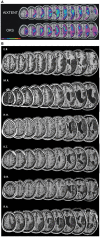Combined space and alertness related therapy of visual hemineglect: effect of therapy frequency
- PMID: 23908613
- PMCID: PMC3727078
- DOI: 10.3389/fnhum.2013.00373
Combined space and alertness related therapy of visual hemineglect: effect of therapy frequency
Abstract
The combined efficacy of space- and alertness related training in chronic hemineglect was tested behaviorally and in a longitudinal fMRI study. Earlier results had shown that both space as well as alertness related training as single intervention methods lead to short term improvement which, however, is not stable for longer time periods. The neurobiological data obtained in these studies revealed differential cortical reorganization patterns for the two training approaches thereby leading to the hypothesis that a combination of both trainings might result in stronger and longer lasting effects. The results of our current study, however, - at least at first glance - do not clearly corroborate this hypothesis, because neither alertness training alone nor the combination with OKS on the group level led to significant behavioral improvement, although four of the six patients after alertness and even more after combined training showed a higher percentage of behavioral improvement than during baseline. Despite the lack of clearcut behavioral training induced improvement we found right parietal or fronto-parietal increase of activation in the imaging data immediately after combined training and at follow-up 3 weeks later. The study design had called for splitting up training time between the two training approaches in order to match total training time with our earlier single training studies. The results of our current study are discussed as a possible consequence of reduced training time and intensity of both training measures under the combined training situation.
Keywords: alertness; neglect; optokinetic stimulation; reorganization; spatial attention; therapy duration; therapy frequency.
Figures


References
-
- Bhogal S., Teasell R., Speechley M. (2003). The role of intensity of therapy in recovery of aphasia post stroke. Stroke 34, 487–493 - PubMed
LinkOut - more resources
Full Text Sources
Other Literature Sources

